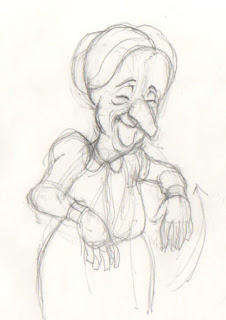Jim on a Limb
This
is the first of my posts in which I am attempting something difficult, a
piece of animation not in the books, and where I am not completely sure
of myself. Plus, I am letting my readers see from the beginning most
of my thoughts and all of my attempts to get it right. In the words of
the Anglo-American expression, I am "out on a limb". For me it will be
an adventure, and I invite you to ride along with me.
Have I mentioned that animating pantomime is harder than animating dialog? Oh, yes.
The
uninitiated think that dialog makes animation more complicated, but in
fact it affords the animator much in the way of guidelines and
direction. The actor's performance, if expert, sets up most of the
timing, emphasis and emotion for the discerning animator. The
performance can inspire the animator to strong poses and
expressions.With a scene that is entirely in pantomime, on the other
hand, the animator is the only actor, and all timing and other nuances
of the performance must come from within.
The scene I
am involved with here concerns three characters--the woman, the man
and the fox--each of whom must be made to perform convincingly not just
in isolation, but in relation to the other two.
And the section of that scene I am focused on now is the most difficult I have faced to date.
The
fox, held in the hands of the man, has bitten the woman in the nose.
In shock and pain, she has pulled away, but the fox has held on, forcing
the man to lift the fox up in order to ease the strain on the woman's
nose. She has stopped, and slowly she lowers her head as the man
carefully lowers the fox. The man then relaxes a little and straightens
himself, his head rising up warily as he keeps his eyes on the fox.
The woman watches the man. Then the man tilts his head for a better
look at the fox. The woman pulls herself into an attitude of
supplication and, looking now at the fox, attempts a forced smile. They end the scene in stalemate.
Let's take a look at some rough key drawings made while working this out.
 |
| Fig. 1. This is the last frame of the action shot where she has just been bitten by the fox and has jerked away. |
|
 |
| Fig 2. This represents an extreme closeup that will last about 30 frames, or 1 1/4 seconds. |
 |
| Fig. 3. First frame as we cut back to the same framing as before. The characters have settled into their poses (compare to fig. 1). |
 |
| Fig. 4. The man and woman, watching each other, carefully lower the fox back down. |
 |
| Fig.
5. They have come down as far as they will go. Short hold. The woman
still watches the man, but he has moved his attention now to the fox. |
|
|
 |
| Fig.
6. The man drops his shoulders and straightens up, He is now
regarding the fox with alarm and confusion. How could this little
animal do such a thing? |
 |
| Fig. 7. He begins to lower his head again but stops, hesitant. |
 |
| Fig. 8. He lowers his head the rest of the way and peers at the fox; he is disappointed and bewildered. |
 |
| Fig. 9. Now the woman turns her attention from the man to the fox. This is an anticipation. |
 |
| Fig. 10. Unsure what to do, she turns her head a little and gestures as if about to speak to a human. |
 |
| Fig.
11. Realizing that that is futile, she instead tries to smile at the
fox (perhaps that will help!), and helplessly brings her fists together
in supplication. |
|
|
So there are the key drawings as I see them now. As of this writing I have not worked out the exact timing.
Wish me luck!
Next: Timing and Spacing, and the First Animatic













